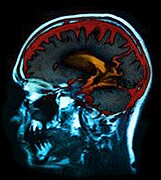
THURSDAY, April 18 (HealthDay News) — The area of the brain that’s activated when people look at numerals such as “7” and “60” has been pinpointed by researchers.
This spot is only about one-fifth of an inch across and consists of 1 million to 2 million nerve cells in the inferior temporal gyrus, the Stanford University School of Medicine researchers said.
The inferior temporal gyrus is known to be involved in the processing of visual information.
Researchers also found that, relative to neighboring areas, activity in this newly identified spot substantially decreased when people viewed numbers that were spelled out (“one” instead of “1”), homophones (“won” instead of “1”) or false fonts in which a number or letter had been altered.
“This is the first-ever study to show the existence of a cluster of nerve cells in the human brain that specializes in processing numerals,” Dr. Josef Parvizi, an associate professor of neurology and neurological sciences and director of Stanford’s human intracranial cognitive electrophysiology program, said in a school news release.
“In this small nerve-cell population, we saw a much bigger response to numerals than to very similar-looking, similar-sounding and similar-meaning symbols,” he explained.
The study in the April 17 issue of the Journal of Neuroscience could open the door to further discoveries about how math is processed in the brain, the news release suggested. It may also help researchers find new ways to help people with dyslexia for numbers and those unable to process numerical information, a disorder called dyscalculia.
Parvizi added that the finding is “a dramatic demonstration of our brain circuitry’s capacity to change in response to education. No one is born with the innate ability to recognize numerals.”
More information
The National Brain Tumor Society offers an interactive tour of the brain.

